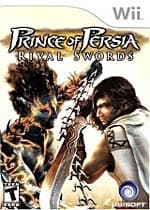Whether you call it Two Thrones or Rival Swords, this is just another Wii-make
When the rumors of a new Prince of Persia game for the Wii started to spread, we were all eager with anticipation. Unfortunately, the excitement didn’t last long; as soon as they announced it would just be a port of the Two Thrones, people started complaining and expressing their disappointment. Hopefully they’ll get back to work and develop a new Prince of Persia installment but, for now, this is what you get. If you never played The Two Thrones, Rival Swords represents good news: this game is one that you shouldn’t miss.

After his remarkable adventures and misadventures in Prince of Persia: Warrior Within, the Prince returns to his hometown Babylon, arriving from the Island of Time. He’s sailing back with Kaileena, his newly found love so they can start a new life back home. When Babylon comes to sight they’re unpleasantly surprised by a city submerged in chaos and devastation; still in flames, Babylon is war-ravaged, invaded by the soldiers of evil and the Prince’s most feared enemy: the Vizier. The Prince’s destiny is not one of happiness, peace, and long-awaited justice; instead, despair and hunger for revenge will mark his path. Kaileena will be sacrificed to unleash the Sands of Time again, and the Prince will set off for a new campaign to recuperate his lost life, crush the Vizier, and eventually take the throne of his kingdom to succeed his father. With the Sands of Time unleashed he can, once again, use time at his will: rewind to avoid undesired events or temporarily slow down time to make things a tad easier.
On his journey, the Prince will encounter numerous enemies that look like terrible beasts of all sorts. With his acrobatic abilities, he’ll get through countless hurdles, jumping from rooftops to rooftops, running through walls, swinging from poles, climbing up and down hanging-chains, and facing the greatest boss battles along the way. The Prince’s possibilities are almost endless, so in more than one occasion you’ll have to use your brain to get him where he needs to go next. Don’t miss ledges, columns, and even long, swaying drapes; everything could be useful. As a result of all the events that happened during this trilogy, the Prince will once in a while transform into his dark self, who has other abilities and a different point of view on things. It’s an interesting and fun feature of the game that almost adds a new dimension to the platforming aspect of it.

This game is not all platform and puzzles. An important part of it is fighting the enemies that get on the Prince’s path; lots of different combo moves make the fights exciting and fun to watch. Here is where the new controls really come into place. The Wii controllers, as you all know, have motion-sensing capabilities; this was applied to the game in a way that makes total sense and adds a bit more to it, although it was an already perfect game on the GameCube, Xbox, and PS2. Swinging the Wii-mote will result in swinging the Dagger of Time (on the Prince’s right hand) and swinging the Nunchuk will move the Prince’s secondary weapon, which you will be able to pick up from the enemies you beat. The secondary weapon doesn’t last forever; it’s probably not “masterfully crafted” like the dagger of time was, so it’s up to you to keep the Prince’s left hand occupied with a new weapon when the previous one wears out.
In the Two Thrones, we used different combinations of buttons to pull different combat moves. On the Wii, practices like two consecutive swings with the Nunchuk and three with the Wii-mote will give you the desired moves. There is a wide variety of them and the controls work just as nicely on the Wii as they did on the last generation consoles. However, you should remember not to go crazy with the controls: swing the controllers smoothly, plan your moves, and get them done right. Use the sword at a sword-wielding pace; don’t overdo it, otherwise you’ll end up with sore arms in no time. In fact, many people that have played the Wii tend to exaggerate their moves, insist in a fast-paced, repetitive motion that leads the gameplay to disaster; then they complain about the Wii not working and being just a gimmicky machine. For all those frustrated gamers, I’d recommend to take a deep breath and just move or swing the controller as if it was an extension of your own hand; act like you would in real life, and you’ll get good (or at least better) results. This will also be the case with the Prince of Persia: Rival Swords. Who said it takes no skill to play games on the Wii?

The rest of the gameplay is executed with standard controls, like the Nunchuk’s control stick to move the Prince and the B button to wall-run. The only complaint I have about the ported controls is the fact that they set the camera on the Wii-mote, by tilting it left or right and up or down. This means that you have to be careful and keep the Wii-mote steady while you’re playing, unless you want to be slammed on your face with a new, ugly camera angle. Luckily, you can turn this off and leave the camera controls exclusively on the D-Pad, on the top part of the Wii-mote. This works much better but still not great for people with smaller hands like me who have to slide their hand forwards to reach those buttons. The camera controls on the standard, “last-gen” controllers were much better.
